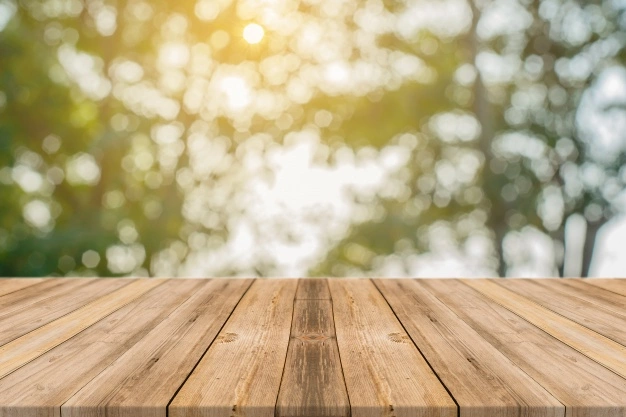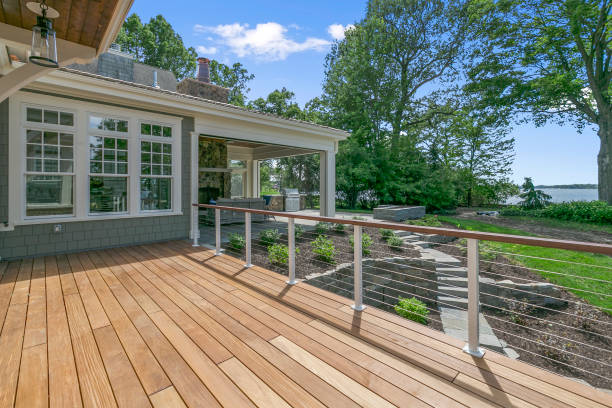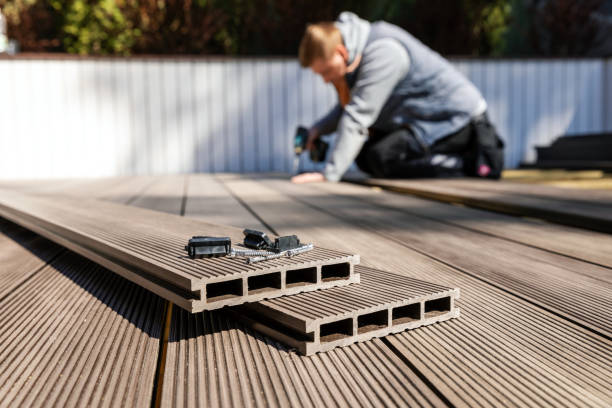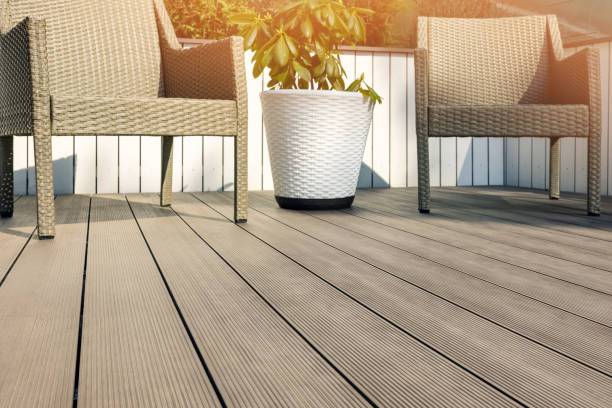How To Clean Composite Decking (in 6 easy steps)
Composite decking is made to be long-lasting and low-maintenance, and you can clean it with common household items like a sponge and a hose. There is no need to rent a pressure washer to do a good job.

Before you start your composite deck cleaning, make sure that you have the following things:
- Bottle of dish soap
- Brush or broom made of medium-strength nylon
- A bucket of warm and clean water
After creating warm soapy water, you’ll need the following things to clean your deck or porch. Here are six easy steps:
- It’s time to get rid of everything in the room. This prevents anything from getting in the way of the cleaning or becoming harmed.
- Remove any loose material from the floor using a brush. Make careful to remove all loose dirt and leaves before you start watering.
- Use warm water to rinse the floor once it has been swept. Soap may be applied more easily when this step is completed.
- Make a mixture of warm water and dish soap. Concentration should be like washing dishes in a sink.
- Start cleaning your deck by putting the brush head in the bucket! Using the soap/water solution, scrub the whole floor with good pressure to get into the nooks and crannies and remove stubborn dirt and grime.
- Rinse the remaining soap and grime from the composite decking once you’ve done cleaning it.
Your deck will be pristine and clean if you follow this procedure! You should replace the furniture and accessories as soon as the floor is dry.
Just take note, to protect your composite deck boards from fading and damage, avoid using any deck cleaner that contains chlorine bleach. In addition, you should not use it in situations where children or pets could be present. Bleach is found in every cleaning solution that includes Sodium Hypochlorite.
Removing Stubborn Stains
If the stain or substance is exceptional, this cleaning process may not remove the discolouration. You should consult the manufacturer of the deck if this occurs.
Cleaners certified by the manufacturers of composite decking are constantly being updated. If you don’t use the cleaners on their recommended list, you run the risk of damaging your deck or voiding your warranty.
Cleaning Composite Decking Of Common Stains & Problems
Eventually, your composite decking or porch will need to be cleaned to remove mildew, mould, food and beverage stains, and other frequent concerns (such as rust stain).
Here are some of the best strategies to deal with typical deck issues:
Mildew and mould
A timber deck can be ruined by mildew and mould, while a composite deck will remain unaffected. There is no danger or damage to the composite decking boards, but you won’t like how it looks on your decking board.
Clean your composite decking with the soap-and-water approach described in the preceding chapter to remove mildew and mould.
General debris
When there are trees nearby, debris like leaves and twigs tends to build on a deck. This general trash may become a breeding ground for mould if the floor becomes moist.
Keeping your deck clean and free of debris is the greatest defence against this problem.
Dirt between floor grooves
Over time, the tiny spaces and grooves between the planks can accumulate dirt and grime. Begin with the soap-and-water approach if this begins to build up.
You can use a pressure washer if this doesn’t eliminate the filth between the boards. Make sure you do the following to preserve the decking while you wash it:
- Use the tip of a fan.
- Maintain a maximum pressure of 1,500 PSI (or the manufacturers recommended PSI)
Food and beverage stains
You may remove even the terrible red wine stains with a dry paper towel, so don’t give up hope just yet!
Using the simple soap-and-water procedure, remove any food or beverage stains left behind after using a paper towel. Unlike wood, composite decks can be easily cleaned of food and drink spills, making them ideal for outdoor entertaining.
Remember always to use clean water!
Oil and grease
Many people love cooking and preparing food on their decks and porches, whether they have an outdoor kitchen or a portable barbecue. This implies that a small amount of oil or grease may wind up on the deck.
To avoid permanent stains, remove any excess oil or grease as soon as possible. You may use soapy water to remove oil and grease off composite decking. The oil and grease may be rapidly removed using this method, leaving no stains.
Pollens
You may notice a thin layer of pollen on your deck if some plants near your home produce a lot of pollen. Even though pollen is not harmful in the long run, You should nonetheless eliminate it as fast as possible.
Pressure washing is the best approach to remove pollen from composite decking.
How To Power Wash Composite Decking
Be sure to follow these four manufacturer-and-experience-backed principles when power cleaning composite decking:
- Make use of a fan nozzle with your pressure washer. In this way, you guarantee that the spray is not concentrated enough to harm the deck’s surface.
- You should never do pressure cleaning your deck at more than 1,500 PSI. Deck surfaces are delicate, and you don’t want to scratch or scrape them. Some manufacturers accept greater pressures than 1,500 PSI, but it’s best to double-check with them first.
- You should keep the power washer a safe distance away from the deck. We advise keeping a distance of at least six inches from the surface. This should be enough to clean the composite decking without causing any harm.
- You should follow the grain of the individual boards. It’s important to follow the grain while power cleaning your deck. This prevents the surface from being scratched or marked by travelling against the grain or passing over many boards.
Removing Snow & Ice From Composite Decking
Although your composite deck may not be used as frequently during the winter months, you may still want to keep the walkways leading to it clearly and safe for pedestrians.
Make sure you use products and tools that won’t damage your composite deck while clearing snow and ice off it.
Look at the safest methods for shovelling or using ice melt products on your deck.
Can you shovel snow off a composite deck?
You can shovel snow off composite decking without hurting the surface! Composite decking is nick, cut, and damaged by shovels with metal cutting edges.
Use a shovel with a plastic or rubber edge to prevent this. The snow is securely removed in this manner without damaging the deck’s surface in any way. You may not even need a shovel to clean your deck if the snow is light. Homes often use a leaf blower or a broom to clear minor snowfalls of less than 1-2 inches.
Can you use a snow blower on your deck?
Large decks or lengthy walks are common features among homes. A walk-behind snowblower may be an option if there is a lot of snow and you have easy access to the ground.
It’s not a good idea to do this. In the same way that a metal-edged shovel harms the composite decking, a snowblower does the same. You don’t want to take a chance or hurt your lovely deck!
Can you use ice melt or rock salt on composite decking?
It’s easy to remove snow with a plastic shovel or a leaf blower, but it’s far more difficult to remove ice or sleet off your deck.
Don’t use any form of the metal object to break or remove the ice. This is important. The ice is removed, but the damage to your deck is also done.
The ice, on the other hand, should be melted. What are the safest ice-melting chemicals for composite decking?
If you’re utilizing a unique brand or chemical agent, you should always verify the manufacturer’s instructions before employing ice melt.
Ice melts containing calcium chloride are generally safe for composite decking and are our preferred method of removing ice. To melt ice without destroying the composite surface, this substance is extremely efficient. It’s also safe for pets to take if they unintentionally swallow it.
Sodium chloride, rock salt and sand are not recommended. Unfortunately, these grains can permanently stain composite decking.
How NOT To Clean Your Composite Deck
If you have a stain or cleaning problem, you may want to use a chemical cleaner to remove it from your deck.
Cleaning a composite surface with this method is never a good idea!
Remember that composite materials clean more easily and effectively than a standard wood deck, thanks to the soap-and-water procedure detailed in Chapter 1.
Don’t just go for the chemical cleaner if you can’t get the stain out with soap and water.
You should never use bleach and other harsh chemicals on composite surfaces. As a result, the composite material may suffer lasting staining and degradation from exposure to these substances.
When removing a mark or stain from your deck, look up the recommended cleaning solutions on the decking manufacturer’s website.
Using a cleaning solution certified by the manufacturer guarantees two things:
- You will not harm your composite decking.
- You will not void any warranties.
Conclusion
Composite decks require less care and cleaning than conventional wooden decks, but homeowners must keep them clean and clear of stains and other undesired things while not being used.
Fortunately, cleaning composite decking with soap and water or a basic power washer is simple.
Get in touch with our team now to learn more about our composite decking options if you already have a hardwood deck you’d want to replace.
For additional inspiration on what you can do with your house and yard, check out our portfolio of completed projects for some ideas.
To get started, reach out to Maintenance-free Garden Glasgow. We’d love to assist you in realizing your goals!








